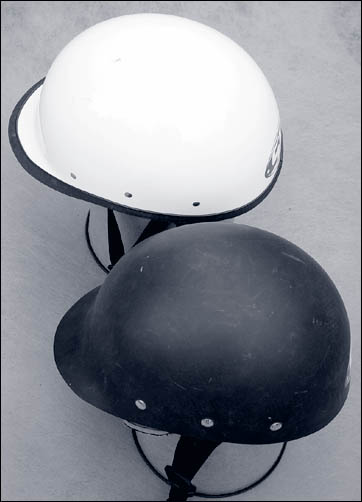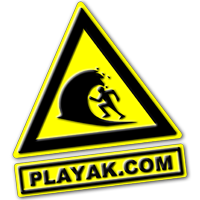[please login to make this ad block disappear]
Articles
Helmet reviews: ShredReady Shaggy and Super Scrappy: the novel.

Helmet reviews are the reviews I take most seriously, so please bear with me on the length of this article.
SUMMARY
| PRO | CON |
|
|
Shaggy: HIGHLY RECOMMENDED
Super Scrappy: RECOMMENDED
I should probably just consolidate all my helmet reviews into one big article, because every time I write one, I find out more and more about helmet safety and marketing that changes my perspective. And I get a little more information to pass on that will hopefully make my readers more educated consumers. So before I launch into the next two reviews, I am going to take a minute and offer some information and perspective on whitewater helmets.
There is one important consideration in all helmet appraisals: there is no American safety standard for whitewater helmets and CE 1385 - the European standard - is considered very weak by the industry. Getting CE 1385 approval is not difficult and to some people's way of thinking does not ensure a helmet which will provide adequate protection in the event of an impact. I mention this in every review, because it's something that consumers need to be aware of.
Given that, there is a broad spectrum of helmets which provide differing degrees of protection. For example, I have a friend from Scotland who assures me that many of the creekboaters there wear full coverage motorcycle helmets when boating - that's probably a good benchmark for the upper range of impact safety. At the other end you have any number of helmets of shoddy design which are inadequate for various reasons such as a thin crush zone (or worse yet an old-school webbing suspension system), flexible shell, bad fit... what have you. CE 1385 doesn't get you very far from the bottom end of the spectrum for safety, and in America, helmets don't even have to meet that standard.
Now enter capitalism and marketing.
What helmets sell well and are popular? Perhaps too frequently helmets sell because of fashion or price. Beginning boaters are reluctant to invest in a good helmet when that money could go to a better boat or paddle, and advanced boaters don't want to look like dorks. In Europe, you can wear a face cage and not feel too silly about it, but they are quite out of fashion in America, so safety takes a back seat to appearance. I'm just as guilty as the next guy.... maybe even more so. Nevertheless, manufacturers will always follow suit and give the public what they want - they have to make money right? And when the next guy is selling more helmets because they are stylish (or less expensive) but not safe, the competition either follows or goes out of business. That's economic Darwinism for you.
So a helmet has to have a formula; a ratio between safety, encumbrance, cost and marketability. Each manufacturer is going to strike a different balance from the next, so there will almost always be some trade off. Say one helmet is very safe but it makes you look like a mushroom cloud, makes it hard to roll because of weight and on top of it all is expensive. Or there's one that looks cool, very light but not very safe and still very expensive. Or cheap, ugly and disturbingly unsafe.
Finally, I don't have access to a materials testing lab. I can't perform impact tests and give objective data like that, so I have to rely on what I know about kayaking, the industry, the product and what I think the market at large generally wants and needs. I took a huge stand against Minicell liners at one point because I found out how much better EPP is - but there are even better materials than EPP out there, so you are just making a risk management decision no matter what your liner is made out of. Lots of kayakers wear Grateful Heads, and they swear by them - so who am I to say they're wrong? For the most part, Minicell seems to get the job done in most cases.
OVERVIEW:
When I first did the review of the Super Scrappy, it was difficult to write - almost all price-point gear is hard to write for, because the manufacturer usually offers a more high-end product that does the same job better. So how do you say "this is good, but you could do better" without deferring to meaningless standards like A is cheaper than B? You really can't, so you're stuck with offering objective facts and an opinion that may differ radically from your readership. I've never written a price-point review that went well because I just don't usually use low-end gear; so I can't honestly say how good or bad it is for a beginning kayaker. So I decided to take a new angle and write the price-point version side-by-side with the high performance model. Let's see what happens.
SUPER SCRAPPY:
I reviewed the Super Scrappy a while ago, basically saying it's a really good price point helmet. After the review went up, I exchanged some e-mail with Tom at ShredReady, who had some more information for me - enough to warrant a correction.
The major correction here is concerning the Hand Of God occipital lock system. In independent safety tests helmet blowback is measured by attaching a hook to the front of the helmet, running it through a pulley and tying a weight to the other end (essentially). The weight is dropped from a prescribed height and the distance the helmet travels back is measured. Helmets using the HOG system rated 0 in blowback. End of discussion, you can't score better than that.
As for the EVA liner and plastic shell.... well, read the intro to this article - it's a give and take formula. In this case you get a lighter, less expensive and maybe to some people a better looking helmet, but the protection offered is going to be less than the Shaggy. You can rationalize this on a mass-marketing level - any helmet that brings consumer cost down, comfort and fit up and weighs less is going to be a huge boon to entry level boaters. Does it provide enough protection for you on a personal level? Ultimately the decision is yours.
I have used the Super Scrappy many times in very shallow rivers in hopes of smashing my head against a rock so I could say for sure what I thought of it. As of yet, I have not taken any crushing blows to the head in the Super Scrappy, but it meets my safety requirements for 90% of the kayaking I do. So when all is said and done, I still give this one a thumbs up.
SHAGGY:
This is one of the more popular helmets out there, and deservedly so. The Shaggy has an extremely stiff Aramid (Kevlar) and glass composite shell. The crush zone is suitably thick EPP foam (though it isn't injection molded like Lidds, rather die-cut) and a bit more pliable than the EPP liner in Lidds. The inner layer is a laminated EVA foam with plush fabric that can anchor Velcro style hook strips, allowing you to move the fit pads around into whatever configuration is most comfortable. For that reason it has a big advantage over Lidds in terms of fit and comfort. And, like the Super Scrappy, it has the HOG system (see Super Scappy Review) which is excellent.
And so, it stands to reason that the Shaggy is more expensive and a bit heavier. But the protection is undeniably there in comparison to the SuperScrappy. While I feel pretty comfortable with the Super Scrappy, I feel completely comfortable with the Shaggy in all the kayak situations I have ever undertaken. If I were to go creeking where I thought there might be a very realistic chance of grinding my face down the side of some riverbed, I would probably opt for something with a facemask. As of the writing of this review however, I haven't really needed one yet. And my face still looks normal.
Both helmets also have hardware above the ears which can accept a very nice pair of rubber and neoprene ear-flaps. I tried these once, and it felt like Cadillac of whitewater helmets. If you paddle in the winter, I highly recommend them.
As much as I try, I can't think of any real faults with these helmets except that if you over-tighten the HOG, your forehead gets sore after a while.
WetDawg.com has a review of the Full Mental Jacket that's worth reading




